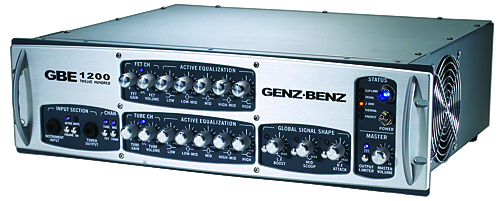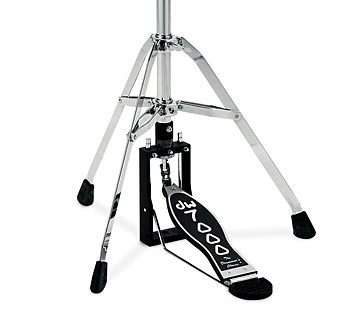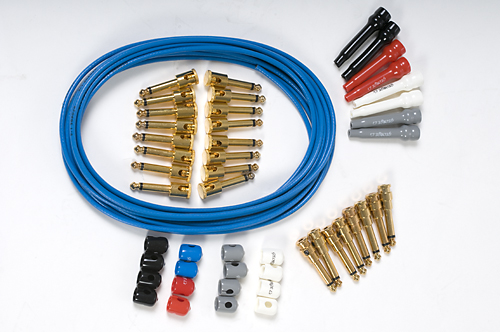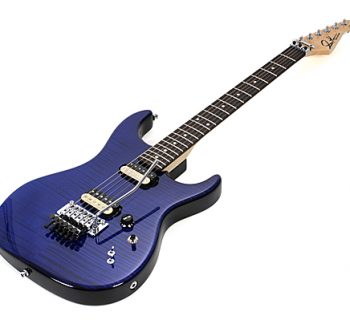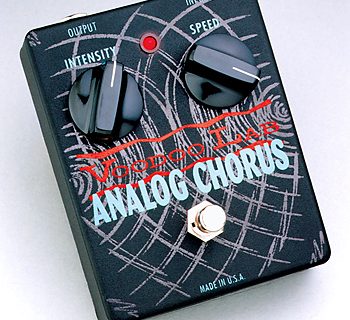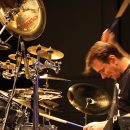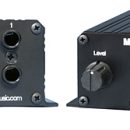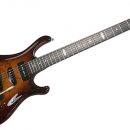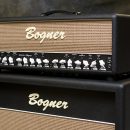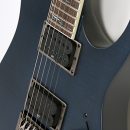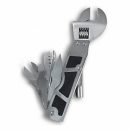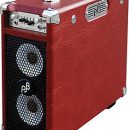2009 marks the 25th year that Genz Benz has been making pro gear — congrats, Jeff!, and the GBE 1200 amp is a testament to their great work. As the big brother of the GBE 600, the 1200 is (obviously) the more powerful, upgraded version that just proves the addage that more power is better! This amp is a multi-faceted monster that has the ability to sound however you want without taking anything away from your instrument. Choosing between tubes and solid state within one bass is always a great pleasure.
| Category | Value | Rating |
| Features | 20% | |
| Usability | 25% | |
| Sound | 25% | |
| Documentation & Support | 10% | |
| Price | 20% | |
| OVERALL RATING = 3.4 3.6 stars or better: Outstanding, WIHO Award 3 stars or better: Worth considering 2 stars or better: Suited to specific needs 1 star or less: Not recommended |
||
The matched speaker cabinets have great response and are extremely portable thanks to built-in handles and wheels. In addition, they are the lightest 4x10 bass cabinets we have ever had the pleasure of lifting. If you have the money for a full rig, the GBE 1200 powering two Uber Bass 4x10 cabinets is, to quote Linda Richmond, “like buttah.”
Features
The GBE 1200 looks about as tough as the wattage it produces, so lets talk about that. This amp pushes 550 Watts at 8 ohms, 1,000 watts at 4 ohms, and the full 1,200 at 2 ohms.
The faceplate and entire front of the head looks like it could be run over by a Mack truck (though we don’t encourage you to try that stunt at home). There are even handles on the front that double as a knob protector in case of a front-side spill.
The input section has an Active/Passive button and a Mute button. This head features two channels: one 12AX7 tube-driven channel and an FET solid-state channel, each with a dedicated 5-band EQ. The great thing about this head is that you can not only switch between each channel but also blend the two together. There are two buttons near the input area that allow you to switch between tube and solid state and another button to blend them.
Additionally, the included footswitch makes channel switching simple. There are five switches on the footswitch: two for the channels and mix, and three for the Global Signal Shape. This feature gives you a low frequency boost, mid-scoop, and a high-frequency attack (you can also engage this feature directly on the head) — nice when you’re looking for a little something extra during your bass solos (you get to play those, right?).
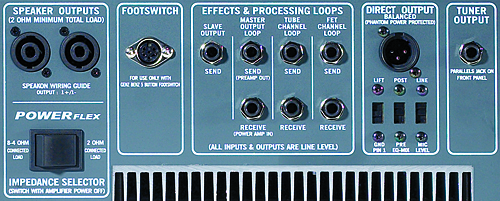 There is an output limiter that bypasses or engages the limiter in the amp, which, according to the manual, “allows simulation of output stage saturation as the amplifier nears its maximum power.”
There is an output limiter that bypasses or engages the limiter in the amp, which, according to the manual, “allows simulation of output stage saturation as the amplifier nears its maximum power.”
Turning the amp around, the speaker outputs are located above the Powerflex switch that sets how many ohms you are running. A really cool feature is that each channel has its own effects loop, as well as a master output loop for a pre-amp. The Direct Out has three switches for a ground lift, a pre/post EQ mix, and line/mic level.
A dedicated tuner output exists on both the front and rear of the amp — handy if you’ve got the head in a rack with a pro tuner.
The Uber Bass 410T 4x10 cabinet features four GNX10250 loudspeakers, a compression tweeter, and an adjustable level control for the tweeter. The ported cabinet has Genz Benz’s Edge Lift handles along the top edges of the cabinet (both the sides and the rear), and wheels on the back bottom edge for easy carting. It’s also a surprisingly light cabinet — only 72 pounds, all around, thanks to the use of neo-dymium magnets in the speakers.
Usability
This amp was very easy to set up, and once we were plugged into both 4x10 Uber Bass speakers we were ready to shake, rattle and roll!
The layout of the amp was easy to get around with each channel and its respective five-band EQ as well as the Global Signal Shape all in their own place. The handles on the front of the head made it easy to setup and breakdown, the knobs were rock solid, and even the buttons on the head seemed ready to be pushed by the mightiest of thunder fingers.
There was no problem using the effects loops, and we were very happy to find that you could have two different loops for the tube and solid-state channels. The DI was easy to set up as well, but surprisingly absent was a level control for the DI output.
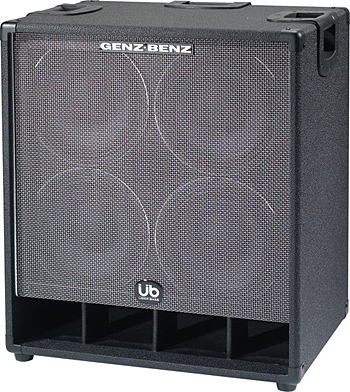 We loved the fact that the GBE 1200 came with a footswitch to control the channels and the Global Signal Shape. We thought that having the means to use the low boost, mid scoop, and high frequency on demand was a great idea. We felt that we could get that extra push by engaging whichever shaping filter we were searching for. The cable for the foot switch was nice and long, too. Although hardwired to the footswitch, we found it more than accommodating for playing on a large stage.
We loved the fact that the GBE 1200 came with a footswitch to control the channels and the Global Signal Shape. We thought that having the means to use the low boost, mid scoop, and high frequency on demand was a great idea. We felt that we could get that extra push by engaging whichever shaping filter we were searching for. The cable for the foot switch was nice and long, too. Although hardwired to the footswitch, we found it more than accommodating for playing on a large stage.
As far as the cabinets were concerned, we loved the wheels/handle and the lightweight design, but were concerned with the safety of the speakers inside. While many bass speaker cabinets have metal grills (or even rigid plastic), the UB cabinets have only a mesh grill cover. Obviously this puts the speakers at risk, particularly in a touring situation, and we could envision easily trashing the grills after only a week or two in a van. But on the other hand, how many Marshall stacks have you seen with shredded covers? We just felt that given the otherwise great design and portability, the speakers should have been better protected.
Sound
This amp just begged to get started at a full 1,200 watts so that's what we did, starting with our Fender ‘72 P-bass to start. We plugged in and used the tube channel first. It sounded big, deep and warm. We beefed up the bass and used the low frequency boost from the Global Signal Shape which gave the bass some booming note projection. We next switched to solid state to hear the difference. The FET (solid-state) channel had more definition and punch at the same EQ settings of the tube channel. We then blended them together and created a pretty great tone with warmth and punch.
We then took the tube channel and applied the low boost using an Ibanez SDGR five-string to really hear the low end. And what a low end it was! The speakers really responded to the low frequency without making the signal muddy in any way. There was an intense amount of low end, but the clarity of our low B, C and D notes was just awesome. We felt that the Ibanez bass got more response out of this amp because of its active electronics.
The passive P-bass we used needed a little help from the shaping filters but still was able to preserve its authentic P-bass tone. This amp proved very versatile, and we can envision using it with a variety of styles. We were able to get a good rock, mid-ranged, tone out of the FET channel, and some slightly mid-scooped and high frequency attack (as well as some really bright punchy slap) came through beautifully with a blend of both channels. The Global Signal Shape really added a ton of high frequency attack.
We were also impressed by how well our effects sounded through this amp — the GBE 1200 loved our Boomerang, Mutron-III, and Bass Balls pedals. We tested the effects loop through each channel, but preferred the tone through the FET channel. We were especially happy with the clarity of our effects and the definition of each note. There was no loss — especially in the Bass Balls pedal. That particular pedal is challenging to get sounding right because of the type of flanger sound that the pedal gives off, but we were able to get it sounding clear as day through the loop.
Overall, this amp sounded great and we thoroughly enjoyed playing it. The GBE 1200 delivered some great tones through its awesome-responding speakers. With this bass rig you’ll definitely get what you paid for.
Documentation and Product Support
The user’s manual was very useful and specific in describing the features. There are images of both the front and back of the amp for reference, and its not preachy at all. There aren't any specific settings to get you started — just the facts about each feature.
There is a design philosophy stated on the cover of the manual that really sets the mood for the amp, and we found the premise to hold true throughout our testing: "Genz Benz amplifiers are designed to maximize your instruments natural tone and feel without imparting additional unwanted coloration or reducing impact and playability. This results in an amplifier that will always be true to your instrument’s basic natural qualities and your personal tone signature."
Price
The GBE 1200 $(1,829 MSRP) sells for under $1,500 and is a quality purchase. It easily competes with any amp in its class, and if you're using the matched speakers, the GBE 1200 will most likely rumble its opposition into the ground.
As for the cabinets, the Uber Bass 410T 4x10 ($1,449 MSRP) will set you back just over $1,100 each — a little steep, but they sound great and have great portability features. These cabinets are obviously voice-matched to work best with the GBE 1200, but their roll-ability and lightweight design make it very tempting to grab them for use with other bass rigs.
Contact Information
Genz Benz
www.genzbenz.com
| Evaluation Short-List |
|

